Gabardine is definitely a formal fabric you can rely on for a polished look. Its tightly woven twill weave gives it a smooth, wrinkle-resistant surface that holds shape well, perfect for business meetings, presentations, or semi-formal events. You’ll appreciate its durability and slight sheen that keeps you looking sharp without feeling stiff. Gabardine works well in cooler seasons and travel, making it practical as well as stylish. Keep exploring to discover how to style and care for gabardine clothing effectively.
Table of Contents
Key Takeaways
- Gabardine is a formal fabric known for its smooth finish and durability, ideal for sharp suits and professional attire.
- Its tightly woven twill weave provides a slight sheen and wrinkle resistance, maintaining a crisp, polished appearance.
- Gabardine suits and garments are perfect for business meetings, semi-formal events, and professional networking occasions.
- The fabric holds shape well, making it suitable for cooler seasons and long wear without losing structure.
- Proper care includes dry cleaning and low-heat ironing to preserve its refined texture and longevity.
What Is Gabardine Fabric?
Gabardine fabric is a tightly woven material known for its durability and smooth finish. When you touch it, you’ll notice its firm yet comfortable texture, making it ideal for formal wear.
It’s usually made from wool, cotton, or synthetic fibers, each lending a slightly different feel and weight. The fabric’s distinct twill weave creates diagonal ribs that not only add strength but also resist wrinkles and creasing. This means you can count on gabardine to maintain a sharp, polished look throughout your day.
Its versatility allows you to find gabardine in suits, trousers, and outerwear, perfect for occasions where you want to appear refined without sacrificing comfort. You’ll appreciate how gabardine balances elegance with practicality.
Historical Background of Gabardine
You’ll find that gabardine was invented by Thomas Burberry in the late 19th century, originally designed for outdoor wear.
It quickly gained popularity for its durability and water resistance, making it a favorite among explorers and military personnel.
Over time, gabardine evolved into a staple fabric in formal fashion, admired for its smooth finish and versatility.
Origins and Inventor
Although many fabrics have rich histories, few have origins as distinct as gabardine’s. You’ll find gabardine was invented by Thomas Burberry in 1879. He created it to meet the need for a sturdy, weatherproof fabric that could withstand harsh conditions yet remain breathable.
This innovation set gabardine apart from traditional textiles.
Here’s what makes its origin significant:
- Invented in England by Thomas Burberry
- Designed initially for outdoor wear and protection
- Made with tightly woven worsted wool or cotton
- Patented for its water-resistant, durable qualities
Early Uses and Popularity
After Thomas Burberry introduced gabardine, its practical qualities quickly caught the attention of outdoor enthusiasts and professionals alike. You’d find it used in trench coats, uniforms, and rainwear because it’s durable, water-resistant, and breathable. Its tough weave made it perfect for challenging weather, so explorers and military personnel relied on it heavily. Gabardine’s popularity grew rapidly, especially in the early 20th century, as people appreciated its blend of function and style.
| Early Use | Reason for Popularity |
|---|---|
| Trench Coats | Water resistance |
| Military Uniforms | Durability |
| Rainwear | Breathability |
| Outdoor Gear | Weather protection |
| Workwear | Long-lasting fabric |
You’ll notice gabardine’s early appeal was all about combining practicality with a polished look.
Evolution in Fashion
As gabardine moved beyond its practical roots, fashion designers began embracing it for its sleek texture and refined drape.
You’ll find that gabardine evolved from a sturdy fabric used in outerwear to a stylish choice for tailored suits and dresses. Its smooth finish makes it a favorite for achieving a polished look without sacrificing comfort.
Over time, gabardine’s versatility allowed it to adapt seamlessly to changing fashion trends.
Here’s how gabardine’s evolution impacted fashion:
- Became a staple in menswear and womenswear formal collections
- Used in elegant, wrinkle-resistant suits for professionals
- Featured in both classic and contemporary designs
- Adopted by luxury brands for its durability and sheen
You can confidently wear gabardine when aiming for timeless sophistication.
Key Characteristics of Gabardine
You’ll want to understand what makes gabardine stand out, starting with its fabric composition and unique texture.
It’s known for being both durable and breathable, offering comfort without sacrificing strength.
Let’s explore how these qualities make gabardine ideal for formal wear.
Fabric Composition Details
Gabardine’s strength lies in its tightly woven twill weave, which gives the fabric a smooth, durable surface and a slight diagonal ribbing.
When you look closer, gabardine is often made from:
- Wool: Offers breathability and natural wrinkle resistance.
- Cotton: Provides comfort and lightweight feel for warmer weather.
- Synthetic fibers (like polyester): Enhance durability and reduce shrinkage.
- Blends: Combine fibers to balance comfort, durability, and appearance.
Understanding these materials helps you choose the right gabardine for your formal wear.
Wool gabardine suits cooler climates, while cotton or blends work better in mild temperatures.
The composition also influences how the fabric drapes and holds its shape, making gabardine a versatile choice for polished, professional looks.
Texture and Durability
One of the standout features you’ll notice about gabardine is its unique texture, which combines smoothness with a subtle diagonal ribbing that feels both refined and sturdy.
This tightly woven fabric resists wrinkles and maintains a crisp appearance, making it ideal for formal wear. When you choose gabardine, you’re selecting a material that holds its shape well, even after hours of wear.
Its durability means it stands up to regular use without fraying or losing its sleek finish. Whether you’re wearing a gabardine suit or trousers, you’ll appreciate how the fabric balances elegance with resilience, ensuring your polished look lasts throughout the day.
This texture and strength make gabardine a dependable choice for those wanting style that endures.
Breathability and Comfort
While gabardine’s durability and texture make it perfect for maintaining a sharp look, its breathability and comfort are just as important for all-day wear.
You’ll find that gabardine’s tight weave doesn’t trap heat, allowing your skin to breathe even in warmer conditions. This makes it a smart choice for formal occasions where you need to stay comfortable without sacrificing style.
Gabardine also offers:
- Moisture-wicking properties that keep you dry
- A smooth finish that feels pleasant against your skin
- Lightweight yet structured fabric for ease of movement
- Resistance to wrinkles, maintaining comfort and neatness
Gabardine in Formal Wear: An Overview
When you choose gabardine for formal wear, you’re opting for a fabric that combines durability with a smooth, refined appearance.
Gabardine’s tightly woven twill structure gives it a slight sheen, making it suitable for sharp suits and tailored garments. It holds its shape well, so your outfit stays crisp throughout the day or evening.
The tightly woven twill of gabardine offers a subtle sheen and excellent shape retention for crisp, tailored looks.
You’ll find gabardine in classic formal pieces like blazers, trousers, and skirts, especially in cooler seasons due to its weight.
While it’s traditionally made from wool, blends with synthetic fibers enhance its wrinkle resistance and longevity.
Wearing gabardine signals a polished, professional look without appearing overly stiff.
Comparing Gabardine to Other Formal Fabrics
When you compare gabardine to wool, you’ll notice differences in texture and appearance that affect your overall look.
Gabardine tends to be smoother and more tightly woven, which boosts durability while keeping comfort in check.
Understanding these contrasts helps you choose the right fabric for your formal wear needs.
Gabardine Vs Wool
Choosing between gabardine and wool for formal wear depends on your priorities for texture, durability, and climate. Gabardine offers a tightly woven, smooth finish that resists wrinkles, making it ideal if you want a crisp, long-lasting suit.
Wool, however, excels in insulation and breathability, perfect for colder conditions or when you need natural temperature regulation. Consider these points:
- Gabardine’s water-resistant quality keeps you dry in light rain.
- Wool suits are generally warmer, better for winter months.
- Gabardine holds its shape well, maintaining a sharp silhouette.
- Wool can be more delicate and may require extra care during cleaning.
Texture and Appearance
Texture plays an essential role in how formal fabrics like gabardine present themselves, and you’ll notice gabardine’s tightly woven structure gives it a smooth, polished surface that stands out among other materials.
Unlike tweed or flannel, which have a more textured or fuzzy look, gabardine maintains a crisp, sleek appearance, making it ideal for sharp suits.
Compared to worsted wool, gabardine feels slightly heavier but still drapes well without excess shine, offering a subtle matte finish that’s both refined and understated.
When you opt for gabardine, you get a fabric that balances formality with practicality, delivering a clean, tailored look that’s perfect for business or formal occasions where a neat, professional image matters most.
Durability and Comfort
Although gabardine shares the formal elegance of worsted wool and flannel, it outperforms them in durability and comfort. When you choose gabardine, you’re picking a fabric that stands up to daily wear without losing shape or texture.
It resists wrinkles better than flannel, keeping you sharp all day. Plus, its tight weave offers wind and water resistance, which worsted wool doesn’t provide as well.
You’ll appreciate gabardine for:
- Its strong, tightly woven structure
- Superior wrinkle resistance
- Breathability that prevents overheating
- Easy maintenance compared to delicate wool
This combination makes gabardine an excellent choice for formal wear that’s both practical and polished, letting you stay comfortable and confident from morning meetings to evening events.
Ideal Occasions for Wearing Gabardine
Gabardine suits and garments fit perfectly into several key occasions where you want to look polished without sacrificing comfort.
Think business meetings or presentations—gabardine’s smooth finish projects professionalism while its breathability keeps you comfortable all day.
It’s also great for semi-formal events like cocktail parties or evening dinners, where you want to strike a balance between formal and relaxed.
If you attend conferences or networking events, gabardine lets you appear sharp without feeling stiff.
For travel, its wrinkle resistance keeps you looking fresh after long hours.
Avoid wearing gabardine in ultra-formal settings that demand tuxedos or very traditional fabrics.
Otherwise, gabardine adapts well for most occasions where smart, neat attire is appreciated, making it a versatile wardrobe staple.
Styling Tips for Gabardine in Formal Settings
When you want to look sharp in formal settings, choosing the right pieces and accessories can elevate your gabardine outfit effortlessly.
Start with a tailored gabardine suit in navy, charcoal, or black to guarantee a classic, polished look. Pair it with a crisp white dress shirt and a slim tie for clean lines. Don’t forget to polish your leather shoes for that finishing touch.
To complete your ensemble, consider these tips:
- Opt for minimal, elegant accessories like a silver watch or cufflinks
- Keep your belt color consistent with your shoes
- Choose a structured briefcase or leather portfolio for professionalism
- Confirm your gabardine garments fit perfectly; tailoring makes all the difference
These small details make gabardine a standout choice in formalwear.
Seasonal Considerations for Gabardine Clothing
To maintain the sharpness of your gabardine outfit throughout the year, you’ll want to contemplate how different seasons affect the fabric’s performance and comfort.
Gabardine’s tightly woven structure offers excellent durability and breathability, making it suitable for cooler months. In fall and winter, the fabric’s weight helps retain warmth without bulk, perfect for formal suits or trousers.
However, during hot summer days, gabardine can feel a bit heavy and less breathable compared to lighter fabrics like linen or cotton. If you still prefer gabardine in warmer weather, opt for lighter weights or blends designed for summer wear.
For summer, choose lightweight gabardine or blends to stay cool and comfortable.
Keep in mind that gabardine’s moisture resistance also makes it a smart choice during shifting rainy seasons, ensuring you stay polished and comfortable regardless of the weather.
Care and Maintenance of Gabardine Garments
Although gabardine stands up well to wear, you’ll need to handle it with care to keep its crisp appearance intact.
Proper maintenance guarantees your garments stay sharp and last longer. Here’s how you can care for gabardine:
- Dry clean only: To preserve the fabric’s texture and structure, avoid machine washing.
- Spot clean promptly: Treat stains quickly with a gentle fabric cleaner.
- Store properly: Hang gabardine items on padded hangers to maintain shape and prevent wrinkles.
- Avoid direct heat: Iron on low heat, preferably with a cloth barrier, to prevent damage.
Common Misconceptions About Gabardine and Formality
Why do so many people misunderstand gabardine’s role in formalwear? You might think gabardine is too casual because of its durable, twill weave, but that’s not the whole story.
Gabardine’s smooth finish and subtle sheen actually make it quite suitable for many formal occasions. The misconception often comes from confusing it with rougher fabrics or assuming its durability means it lacks elegance.
You should know that gabardine can be tailored into sharp suits and dresses that rival traditional formal fabrics like worsted wool. However, it’s less common in ultra-formal settings like black-tie events, which fuels the confusion.
Understanding gabardine’s versatility helps you choose the right garment and avoid underdressing while still looking polished and refined.
Frequently Asked Questions
Can Gabardine Fabric Be Used for Casual Wear?
You can definitely wear gabardine for casual occasions. Its durable, smooth texture makes it versatile, so you’ll look sharp without being overdressed. Pair it with relaxed pieces to keep your look effortlessly stylish and comfortable.
Is Gabardine Suitable for Summer Suits?
Imagine you’re at a summer wedding wearing a lightweight gabardine suit—it breathes well and resists wrinkles. You’ll stay comfortable and sharp, making gabardine a smart choice for stylish summer suits in warm weather.
How Does Gabardine Fabric Handle Moisture?
Gabardine handles moisture pretty well because it’s tightly woven, which helps repel water to some extent. However, it’s not fully waterproof, so you’ll want to avoid heavy rain or damp conditions to keep it looking sharp.
Are Gabardine Garments Environmentally Friendly?
You should know 60% of gabardine is made from synthetic fibers, which aren’t very eco-friendly. If you want sustainable options, look for gabardine blended with organic cotton or recycled materials to reduce environmental impact.
Can Gabardine Be Dyed Easily?
You can dye gabardine, but it depends on the fiber content. Wool gabardine takes dye well, while cotton or synthetic blends might need special dyes or treatments. Always test a small area first for best results.
- Does Chiffon Fabric Stink - July 15, 2025
- Does Chiffon Fabric Affect the Economy - July 15, 2025
- Does Cotton Fabric Have a Nap - July 15, 2025







